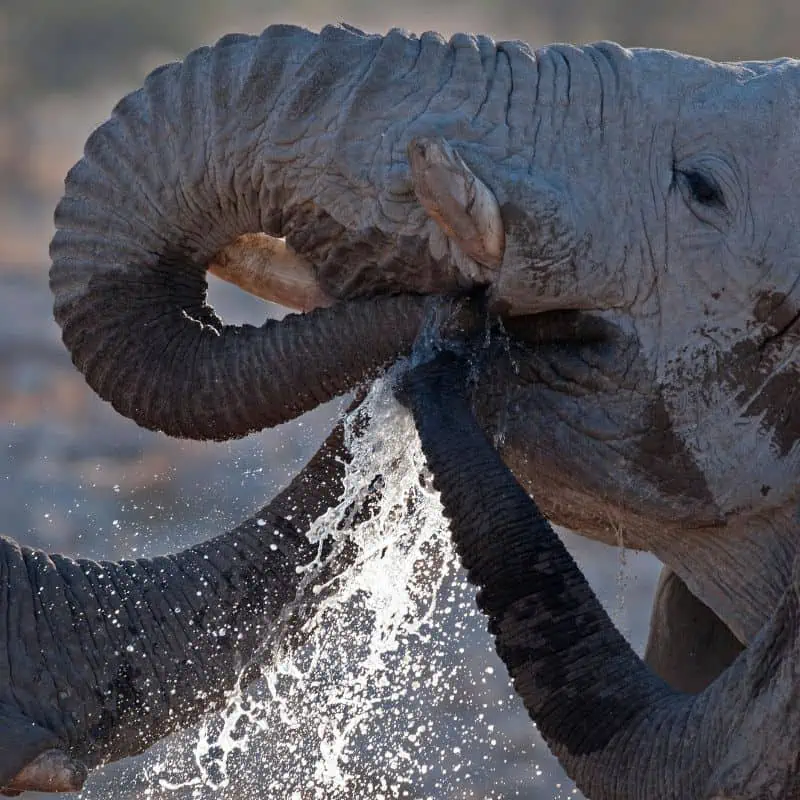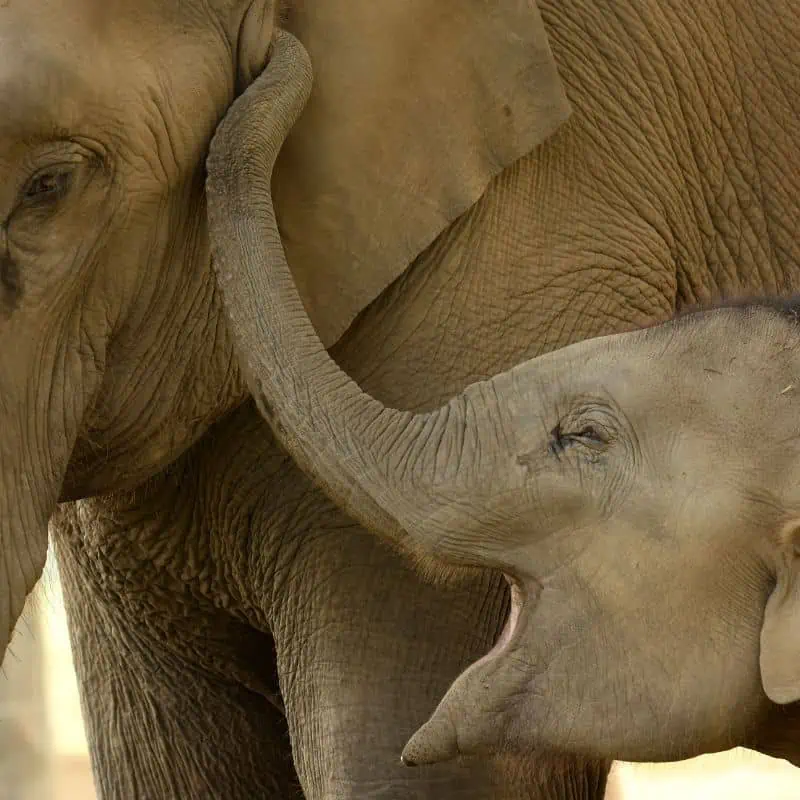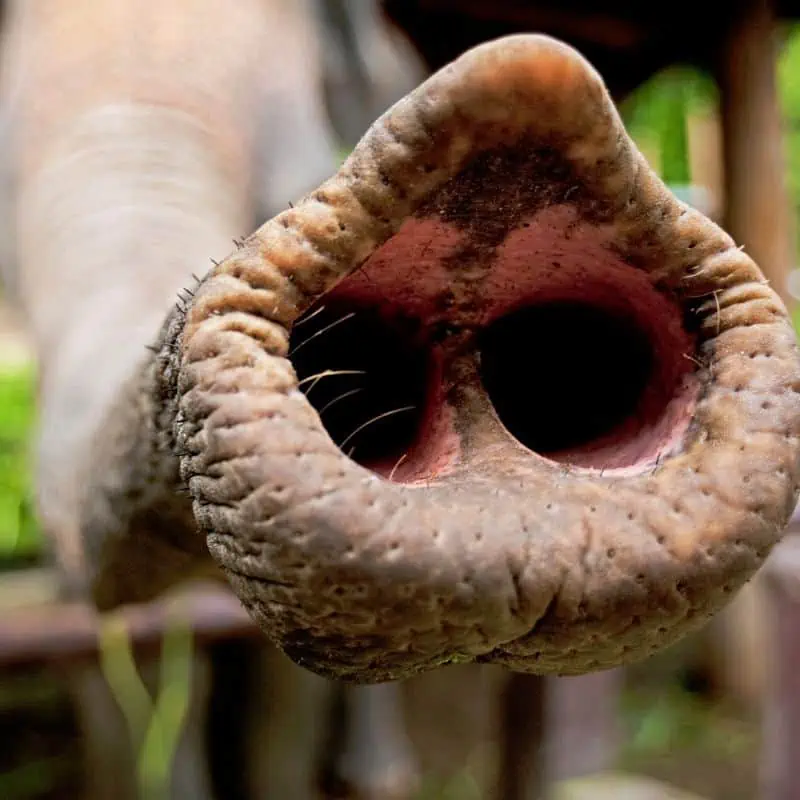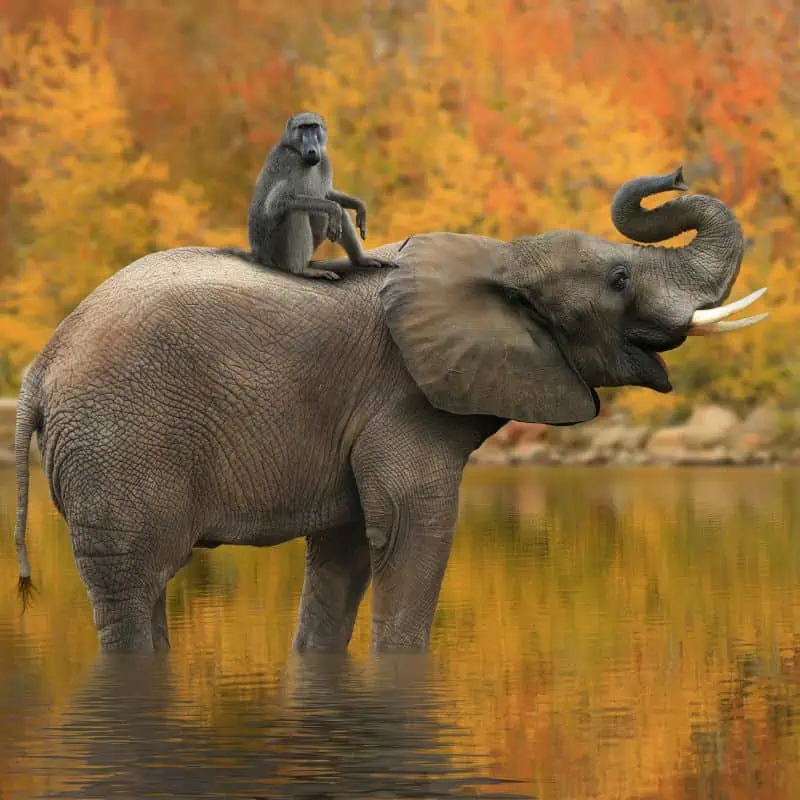A true marvel of nature is the elephant trunk. The elephant shrew, anteater, and tapir have variants on a similar appendage, but no other species in the world has one like it. But is an elephant’s trunk used as a type of nose, a portion of the mouth, or something completely different?
The elephant’s trunk comprises its top lip and nose and is officially known as a proboscis. The elephant’s trunk functions as both a nose and a mouth. They can grasp, drink, smell, and express affection with their trunk. Due to the strength and agility of these fingers, the elephant can pick up a little peanut, crack open the shell, and then consume the whole nut.
This article will look closely at an elephant’s trunk, structure, functions, and superpowers and mention some interesting, fun facts. So, let’s get started.

The Elephant Trunk And Its Structure
The elongated trunk can be as long as 2 to 3 meters. It’s meant to be the most essential and sensitive part of an elephant’s anatomy; its original function is to help an elephant fight for its survival.
The trunk itself is hefty and weighs up to 140 kg.
The elephant trunk contains around 40,000 individual muscles with no bones and is made of a small amount of fat. Compared to 600 muscles in a human body, elephants have way more muscles in their trunk.
The muscles can be of two types:
- Superficial muscles include the dorsals, ventral, and laterals.
- Internal muscles can be transverse and radiating.
How is the trunk connected to the elephant’s body? The bony opening in an elephant’s skull connects the trunk to the head.
The proboscis nerve, in particular, linked from the brain to the trunk, controls the movements of the trunk.
Fun Fact: Surprisingly, the trunk of an elephant fetus is separate from the upper lip before birth. However, after the baby elephant is born and the development starts, the trunk becomes fully functional as the upper lip joins the nose.
Since no bones support the trunk, it has to carry its weight and the weight of anything picked up.
This is only possible due to the presence of 150,000 bundles of separate muscle fibers that internally make up the structure of the trunk.
The cartilage rings balance the two nostrils on the end of the trunk, which can be as heavy as 140 kg and pick up stuff quite as heavy.
The Functions of an Elephant’s Trunk
J. Shoshani, in his famous work called Understanding proboscidean evolution (1998), reveals that the elephant trunk has several uses, such as breathing, touching, smelling, holding, and producing sound.
Let’s dig into the detail of these functions and learn a bit more:
1. Drinking and Eating
The elephant’s trunk is mainly used for eating and drinking. Stretching up or kneeling might be difficult when you have two long, pillar-like thighs and a big, weighty head.
This function is made easier by the elephant’s long trunk, which enables it to search for food without turning its head.
Additionally, the trunk can suck up and spray about 12 liters of water for drinking.
Elephants must consume and digest a vast quantity of food daily since they are strict vegetarians and have a large body mass.
The fibrous vegetation is ground into a digestible pulp by their large, flat, grinding teeth, and the trunk can be beneficial by actively looking for and locating extra food.
No need to stop chewing to graze when you’re an elephant.

2. Smelling
An elephant’s periscope trunk can search for members of its family, prospective attackers, and food or water supplies thanks to a smelling sense which is up to four times stronger than a bloodhound.
Additionally, due to its length and agility, it can accurately detect the direction of the scent. Once more, helpful when you are unable to move your enormous head.
3. Communicating and Socializing
Elephants may use their trumpeting vocal sounds to converse with other members of their herd and convey a message to competitors or even different species by altering the size and form of their nostrils.
Elephants sometimes greet one another by intertwining their trunks, especially with friends or relatives, like a handshake or embrace.

4. Storing Water
A grownup African elephant’s trunk can hold 12 liters of water. They frequently spray water over their body after sucking it with their trunks to keep cool in hot settings.
African vs. Asian Elephant’s Trunk
Elephant trunks from different continents have slightly varied designs, i.e., Asian vs. African trunks.
The trunk of an African elephant is less stiff to the touch than the trunk of an Asian elephant and contains more noticeable rings on it.
Asian elephants can perform more complex tasks because they have stronger trunk muscles than African elephants.
Their trunks’ tips also differ significantly; African elephants can pick up and control items with the help of the two separate “fingers” on their trunk.
Asian elephants make up for their lack of a second “finger” at the end of their trunk by grasping things against the underside.

The Symbolic Meaning of an Elephant’s Trunk
Elephants may symbolize several things, including luck, power, and protection. How can an elephant trunk and its direction convey good or bad luck?
The trunk is highly valued even by people who are just mildly superstitious, such as passionate collectors.
What Does An Elephant With Trunk Up Mean?
It’s believed that an elephant trunk facing upwards will bring power, luck, wealth, and peace. The elephant extends its trunk in welcome and joy.
Place an elephant on the altar with its trunk facing upward means receiving blessings and compassion.
Elephant sculptures with upward-pointing trunks are considered exceptionally good and prosperous for homes.
Elephants standing on their hind legs with trunks up symbolize strength and protection. In statues, an elephant’s trunk pointed upward also stands for success and wealth.

Final Thoughts on Elephant Trunk
When you think about elephants, you automatically picture their enormous trunk. If you have read the article above, you’d know how vital a trunk is for an elephant’s survival.
The trunk balances out an elephant’s large and hefty body. Nature has a balance to everything.
FAQs
Are There Bones in Elephant Trunks?
There are no bones in elephant trunks. It is primarily a muscular organ with a little bit of fat. An elephant’s trunk has around 40,000 muscles.
What is The Mechanism of an Elephant Trunk?
The exact motions of the muscles within it move an elephant’s proboscis trunk. These muscles and the proboscis nerve enable them to move their trunk in whatever direction.
How Strong Is An Elephants Trunk?
Elephant trunks can lift up to 770 pounds. Although it is used more as a tool, it can be very powerful.

